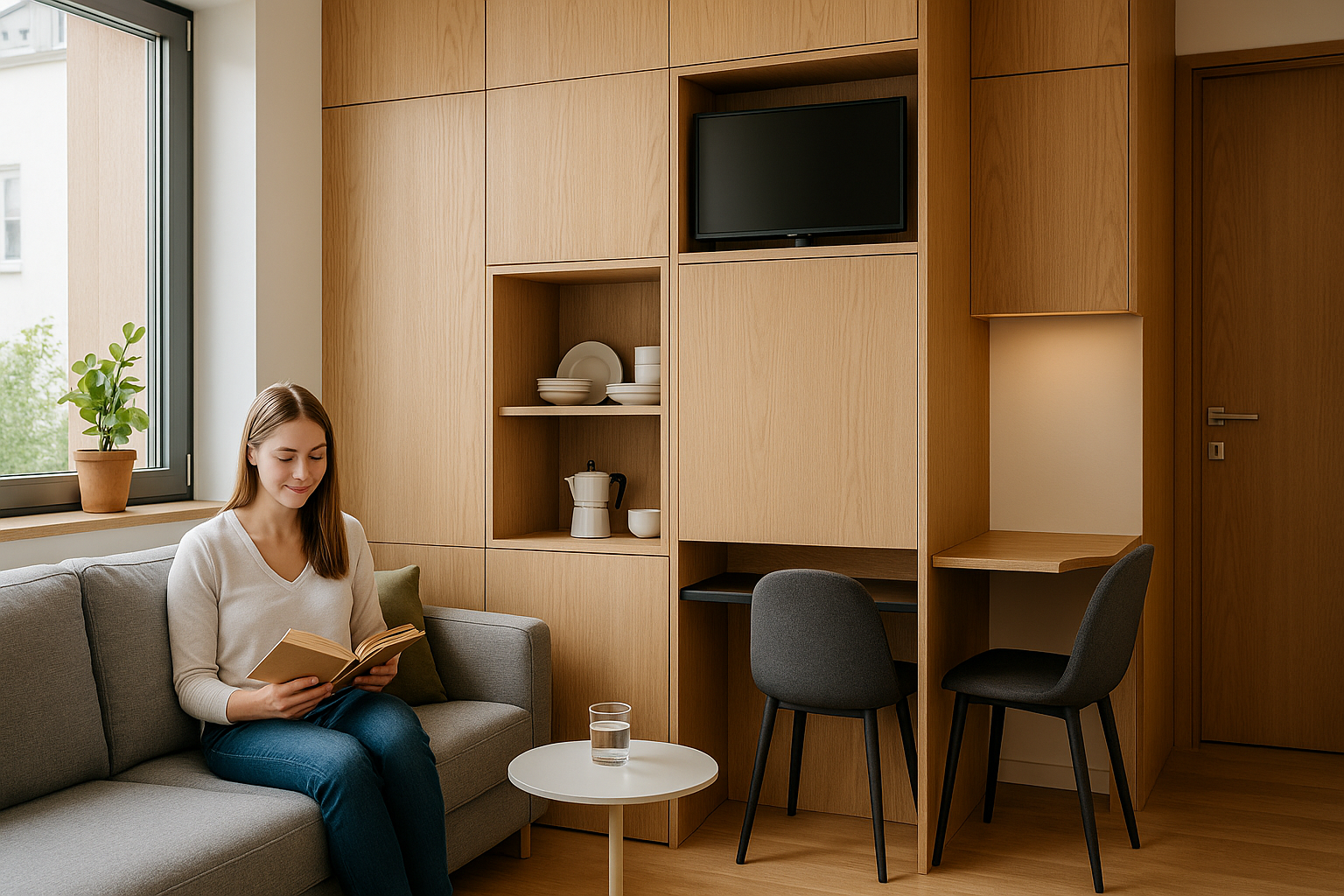Why Timber Veneer Works So Well in Small Spaces
Before diving into the ideas, it’s worth understanding why timber veneer is such a smart choice in compact design:
- Lightweight: It’s applied over MDF or plywood, making it ideal for slim cabinetry, wall panels, and shelving without unnecessary weight.
- Customisable: Available in a wide variety of species, tones, and grain patterns, timber veneer suits everything from minimal to rustic interiors.
- Cost-effective: You get the real timber look—without the cost or environmental impact of solid wood.
- Visually Expansive: The grain lines and organic patterns add a sense of movement and depth that makes a space feel larger and more dynamic.
1. Vertical Wall Panelling to Create Height
Vertical timber veneer wall panels draw the eye upward, making ceilings appear higher and rooms feel more open. This works particularly well in tight lounges, hallways, or apartment bedrooms.
Design Tip: Opt for light-toned species like oak or ash, and run the grain vertically to keep the look clean and expansive.
2. Streamlined Built-In Cabinetry
Custom-built-ins are a staple of small-space design. Timber veneer helps you create flush, wall-hugging cabinets that look seamless while hiding storage, appliances, or workspaces.
Design Tip: Use the same veneer across panels and cabinetry for a cohesive, architectural look. It reduces visual clutter and makes the space feel deliberately designed.
3. Floating Shelves & Slimline Furniture
Floating timber veneer shelves are ideal in small homes—visually light, highly functional, and great for display. The same goes for compact furniture like side tables, desks, or consoles in veneered finishes.
Design Tip: Choose dark species like walnut or teak for dramatic contrast, or stick to lighter timbers like birch for a breezy, Scandinavian-inspired vibe.
4. Feature Ceilings for Added Depth
Ceilings are often ignored, but using timber veneer here can bring warmth and dimension to tight spaces like bedrooms, lounges, or study areas.
Design Tip: Try a matte or satin-finished veneer ceiling with integrated lighting for a moody, high-end effect that draws attention upward.
5. Sliding or Folding Doors to Save Space
Instead of swinging doors that eat up precious floor area, use timber veneer on sliding or bi-fold doors. They’re perfect for room dividers, wardrobe doors, or laundry nooks.
Design Tip: If sound insulation is important, consider acoustic-rated veneer panels—especially in home offices or media rooms.
6. Veneered Room Dividers for Flexible Layouts
Timber veneer partitions or sliding panels are a stylish way to define spaces without building full walls. Use them to separate sleeping zones in studio apartments or to segment off study corners in open-plan living areas.
Design Tip: Slatted timber veneer designs allow light to filter through, while still creating a defined space.
7. Add Accents: Headboards, Backsplashes & Features
In a compact home, even small feature details can make a big statement. Timber veneer is perfect for feature walls, bedhead panels, or even kitchen backsplashes.
Design Tip: Keep the look clean and simple. Let the grain and tone be the hero, without crowding the space with too many materials.
8. Use Satin or Matte Finishes to Keep Light Flowing
While high-gloss finishes can look striking, they often highlight fingerprints and reflections in small rooms. A satin or matte timber veneer finish diffuses light gently, helping the room feel brighter and more open.
Design Tip: Avoid heavily grained or very dark veneers on large surfaces in small rooms—unless it’s a single accent area balanced with lighter finishes.
9. Mix with Other Materials
To keep your space feeling fresh and layered, pair timber veneer with other light, contrasting materials:
- Black metal for a modern-industrial edge
- White stone or quartz for kitchen or vanity accents
- Soft upholstery for balance and comfort
Design Tip: A restrained palette of 2–3 materials ensures the space feels unified and not over-styled.
10. Small Space, Sustainable Choice
Timber veneer supports low-impact living. It uses significantly less wood than solid timber, reduces waste, and often comes from sustainably managed forests. That makes it a smart environmental choice, especially in compact homes designed for efficiency.
Big Design Wins for Small Spaces
Small interiors are where smart design truly shines—and timber veneer is one of the most effective tools in your kit. It’s lightweight, flexible, stylish, and sustainable—perfect for kitchens, bedrooms, lounges, and commercial fit-outs with limited space but unlimited potential.
With the right layout, grain direction, finish, and detailing, you can turn a modest floor plan into something special—functional, comfortable, and visually elevated.
Explore our premium range of timber veneers, plywood, and decorative panels at Bord Products. Have a design in mind or need help with your selections? Contact our team or browse our resources hub for more inspiration.

Explore Bord Products
Our Melbourne facility produces hundreds of veneer and laminate panels daily, giving us total control over timeframes and quality.

Visit Our Showroom
Get expert advice on material selection for your project and see our entire range of veneers and laminates in person.

Specify Sustainable
We support sustainable forest management in Australia and across the globe. Look out for certified products on our website or speak to us.




